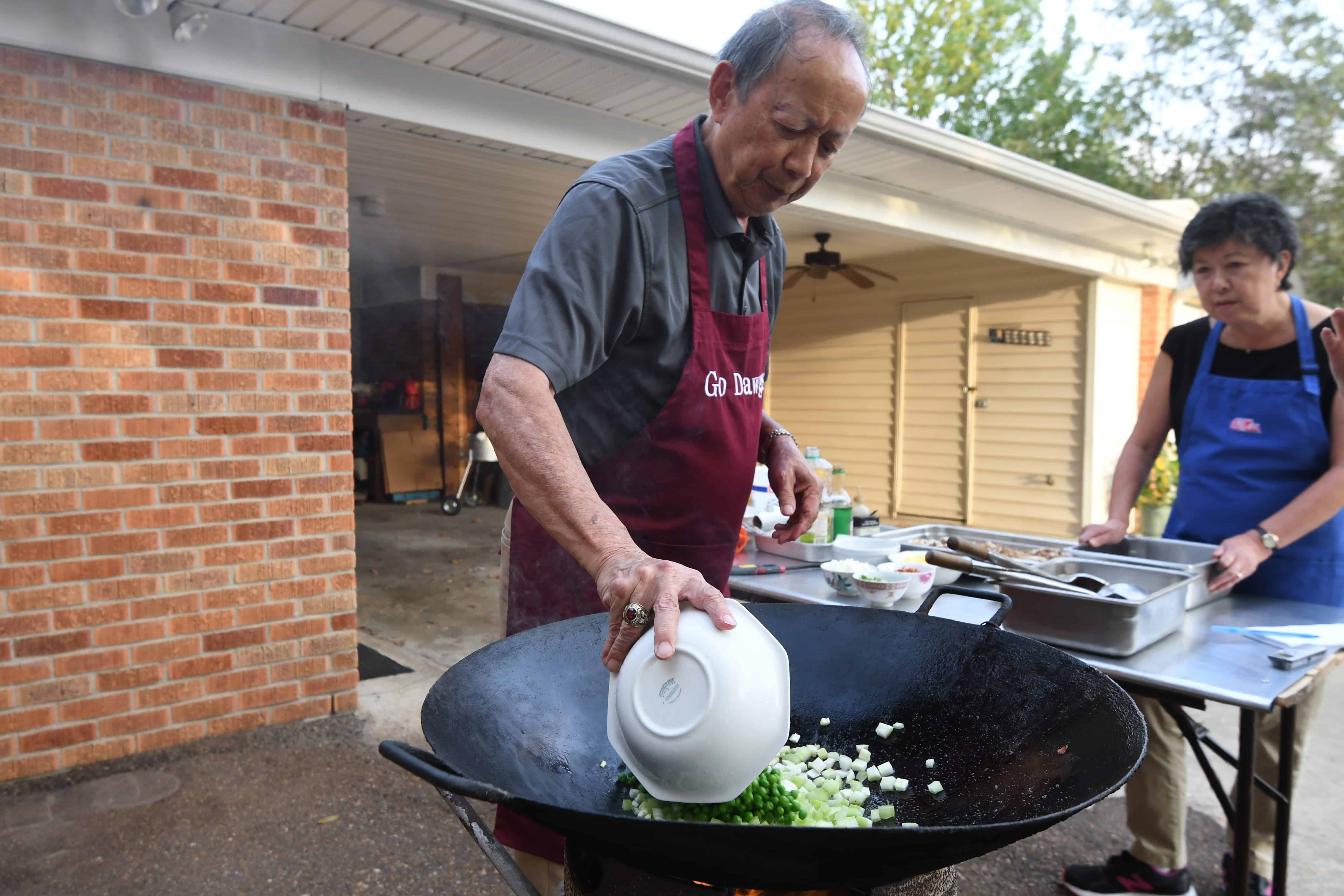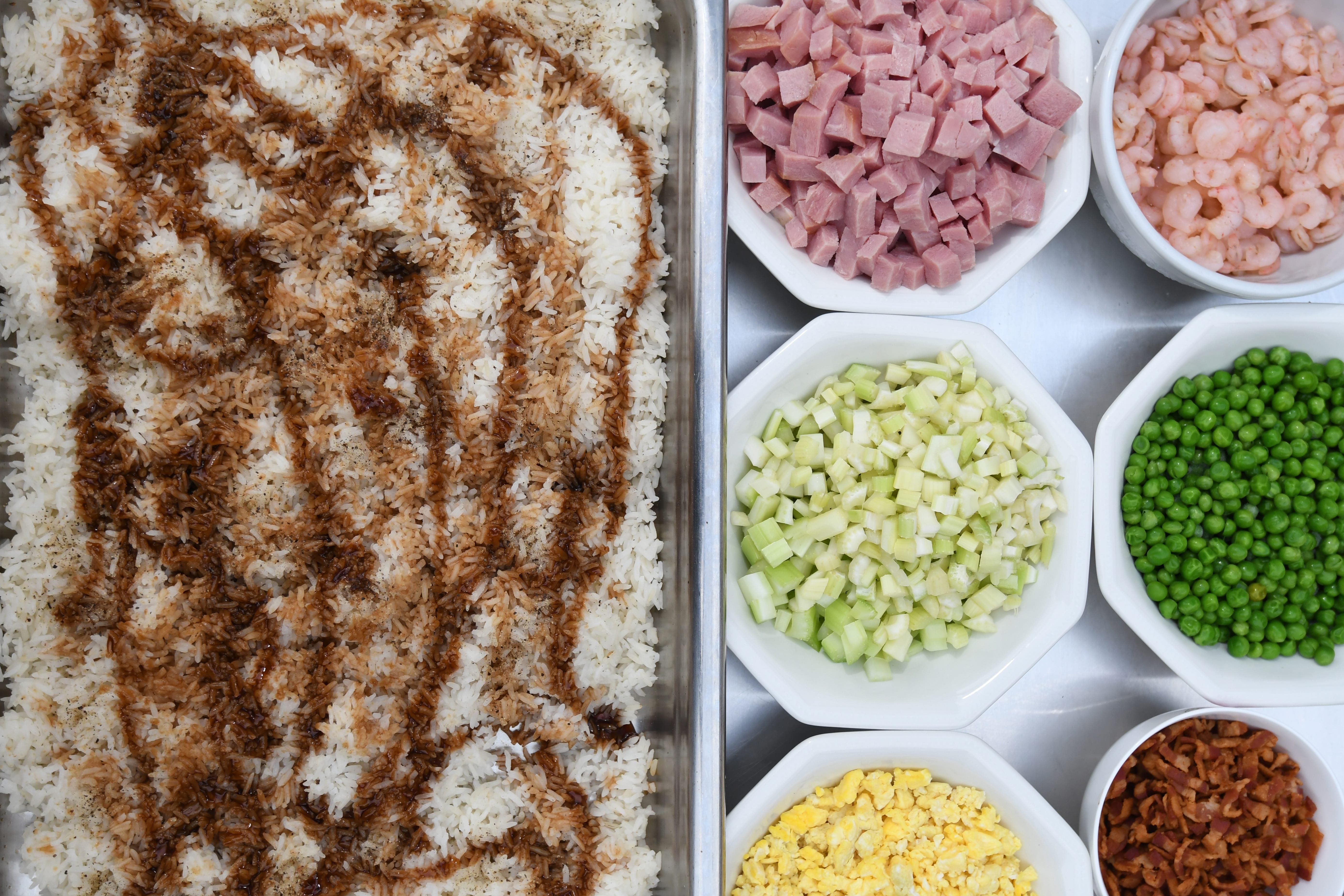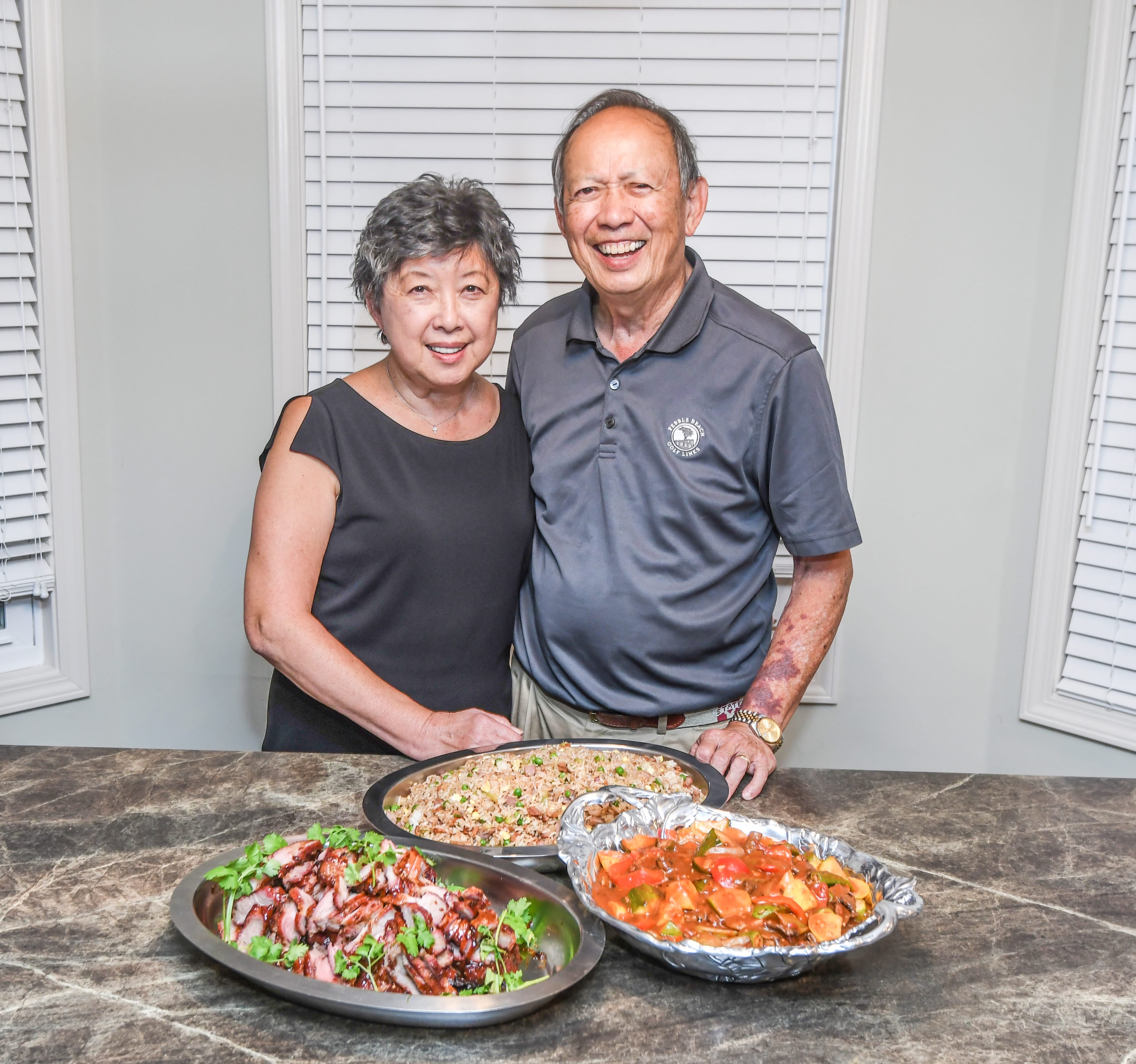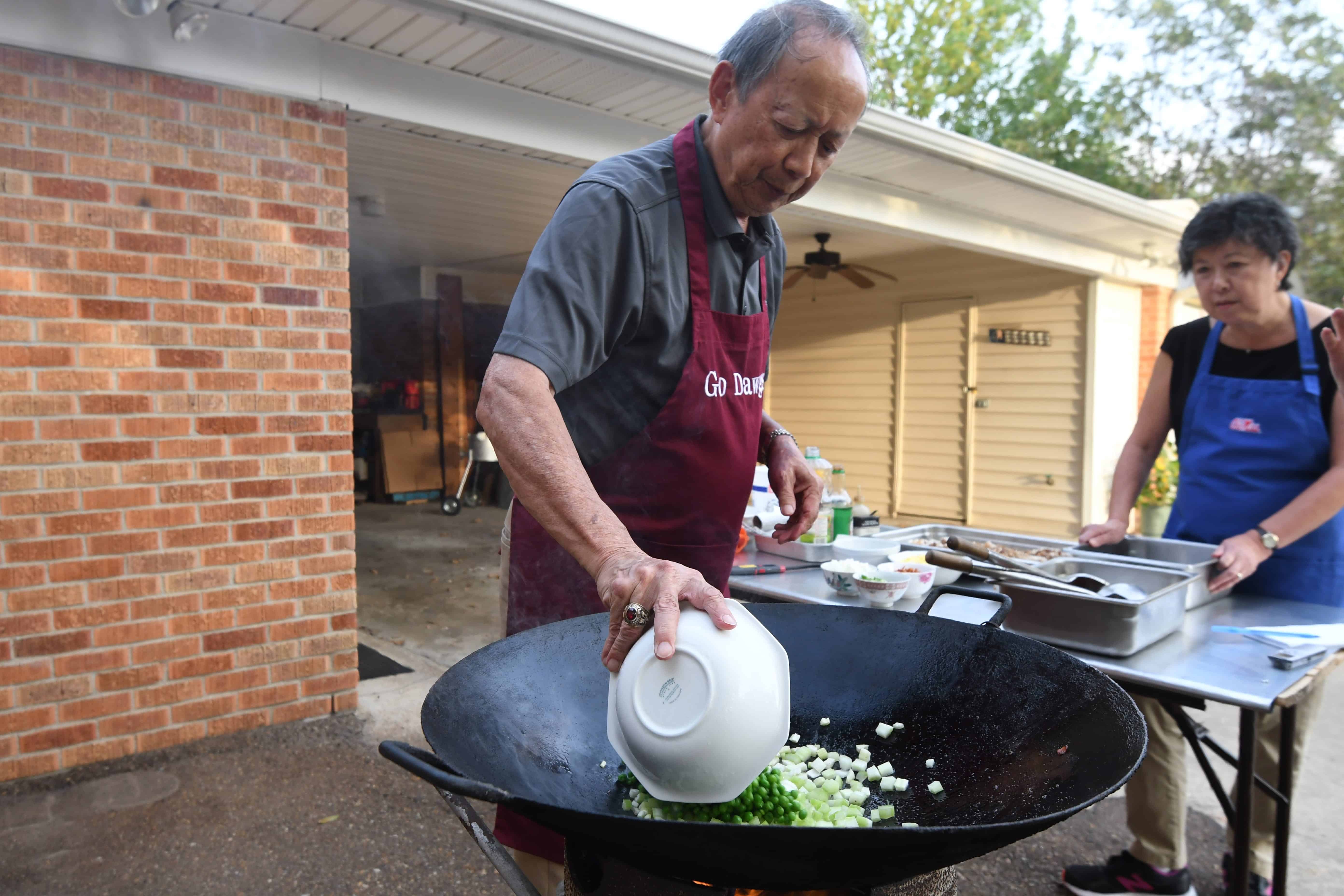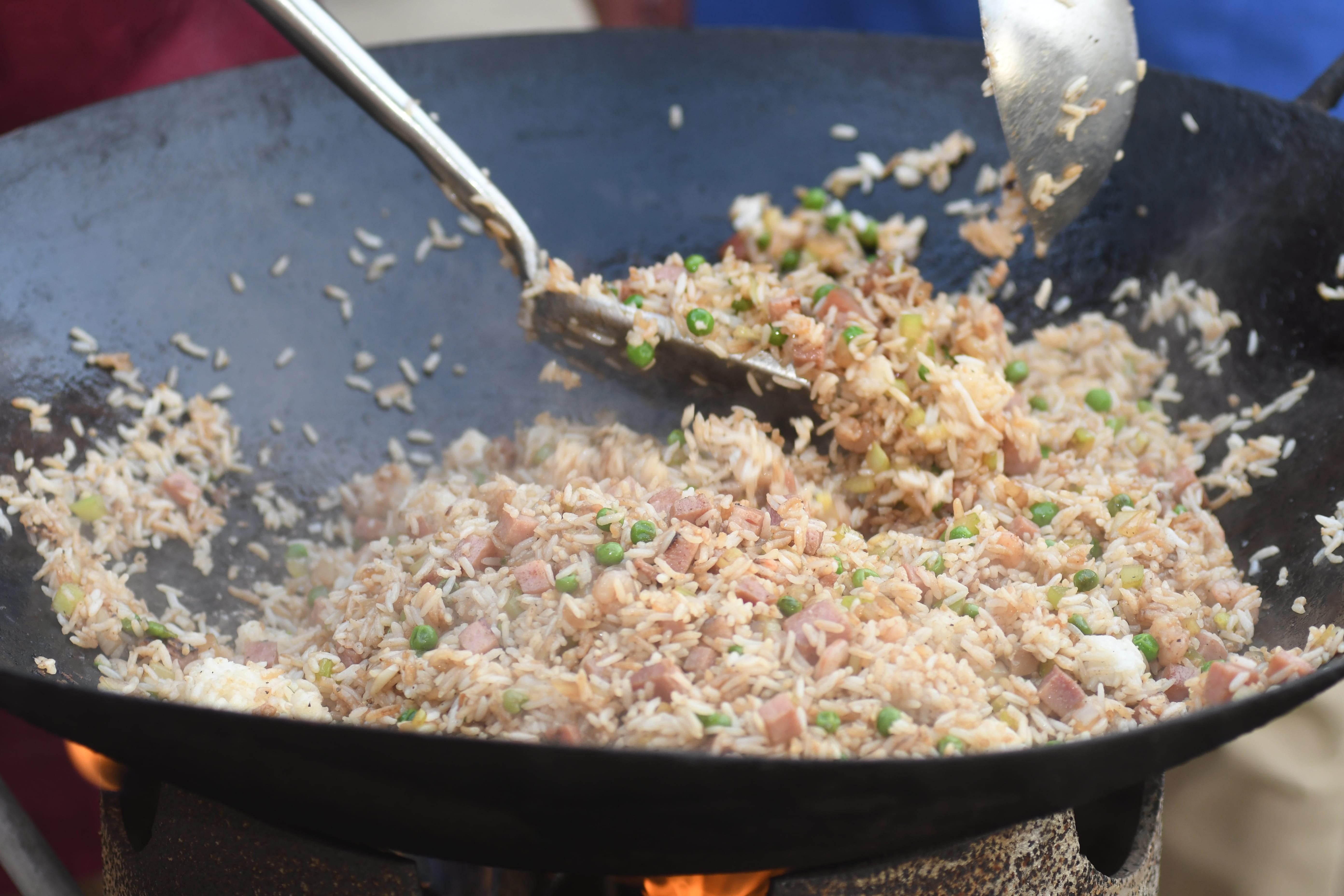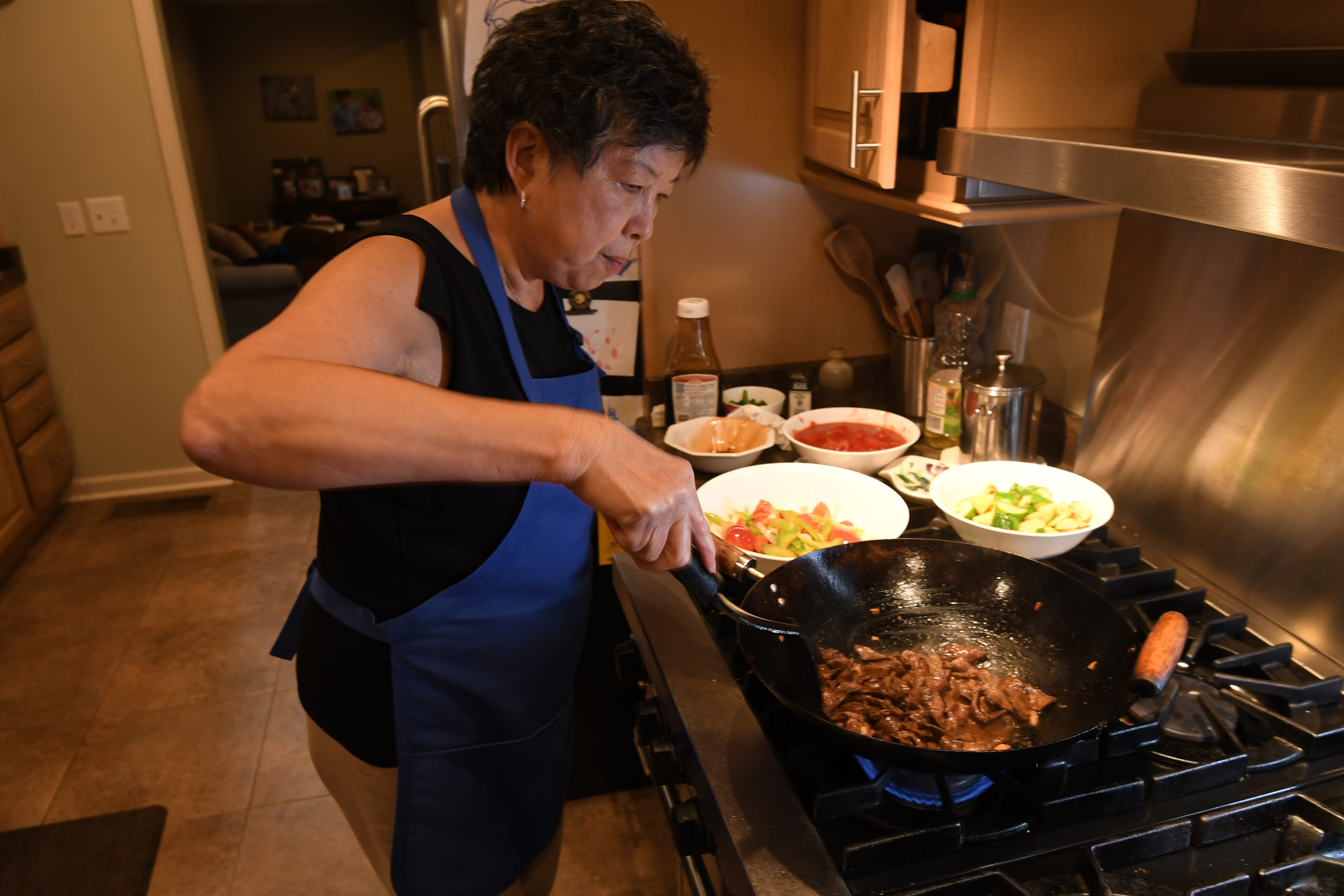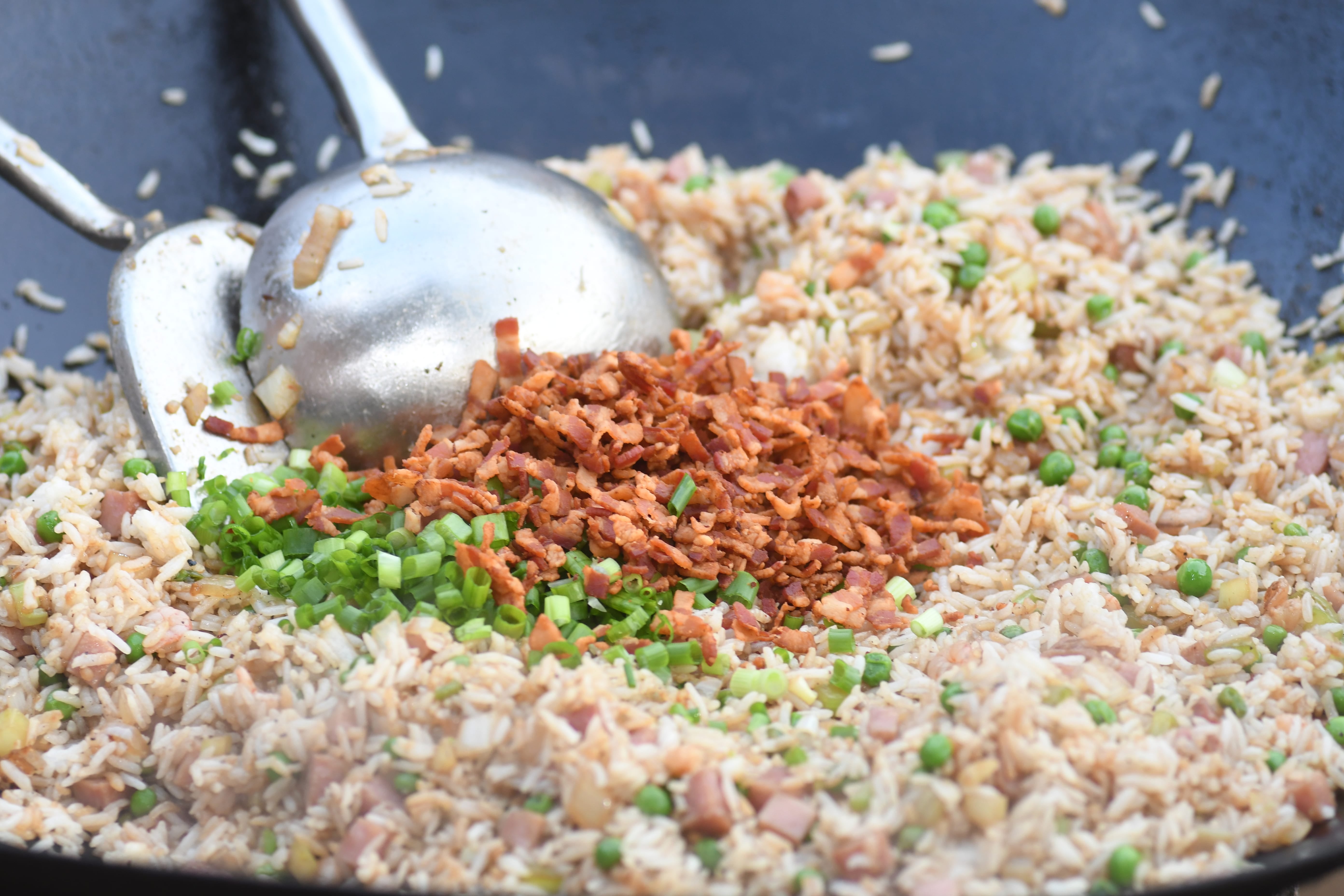BY SHERRY LUCAS
PHOTOS BY BRUCE NEWMAN
The wok, 24 inches across, holds as many memories as it does grains of rice. Seasoned by countless celebrations and holding the warmth of 46-plus years of marriage in its swooping sides, it’s no wonder Gilroy and Sally Chow have dubbed it “the heirloom wok.”
“My uncle gave it to us when we got married, so it’s been in the family nearly 50 years,” Gilroy says. He hasn’t passed it on to his son or son-in-law. They have their own woks in use, in Germantown and Memphis. But that hasn’t stopped their eyeing this one, Sally says, and wondering out loud, “Who is going to get the heirloom wok when the time comes?”
“It will be an arm wrestle,” Gilroy predicted, with a quick check at the flames heating the treasure in front of him. “It’s seasoned because it’s seen a lot of food in its day.”
So have the Chows, who have welcomed ingredients from their Mississippi home into the traditional dishes of their Chinese heritage. Their passion for food — preparing and sharing — has been the couple’s passport to yet another celebration. Gilroy and Sally Chow are among the 30-plus Chinese and Asian American chefs featured in “Sour, Sweet, Bitter, Spicy: Stories of Chinese Food and Identity in America,” through Sept. 10 at the Museum of Chinese in America in New York City. The dozens or so honored range from Michelin-ranked chefs and TV personalities to home cooks, all with personal stories that define Chinese food in America.
At the Chows’ Clarksdale home, the heirloom wok holds their story of a crossroads where cultures intersect and some Mississippi Delta ingredients hop in for the ride. Southern fried rice is where they’re headed this night. The wok fits neatly atop a cooker on wheels custom-made by Gilroy, a retired engineer whose career included building lunar modules for NASA. He lifts it to show off the propane cooker’s innards. “You don’t see this anywhere else,” Gilroy says. “This is completely homemade,” with steel plates, pipes and holes to maximize heat at the bottom, “and that’s very intentional.”
A toss of salt hits the iron and gravity pulls a swirl of oil toward the center. Garlic and ginger sizzle there at the start, then a confetti of ingredients joins the party. Shrimp, peas, ham, celery, onion, egg, bacon and a lot of cooked and seasoned rice go in, all in optimal order.
“Two things make it Southern, that you don’t see in (Chinese) restaurants,” he says. “It’s the bacon and the ham.”
Other details score Mississippi points. Gilroy’s apron is maroon with a “Go Dawgs” motto while Sally’s is bright blue and sports an “Ole Miss” patch, honoring their respective alma maters. It doesn’t stop there. Each year’s Egg Bowl win determines prime placement for other team decor. Sally laughed. “We have the changing of the flag and the changing of the car tag ceremony.”
“I was very sad this year,” Gilroy says. In cooking, though, one team rules. “You see where we work together. That works better. Gilroy’s focus was riveted to the rice, his tools — a wok shovel and ladle — in near constant motion in a choreography of scrape and stir. Sally leaves that job, strenuous with such amounts at play, in her husband’s hands.
“I think one of the reasons for my fried rice reputation is because of the seasoning on each grain of rice,” he says. Sequence is key, to keep the ingredients bright, colorful and intact. “You don’t want to melt anything. It looks kind of casual, but there’s a purpose and a reason for just about everything.”
To finish, he scoops a white spoonful from a small bowl and dribbles it along rice mound’s outer rim. The hot wok melts it into instant flavor that slides down to join the medley. “Bacon fat. From the bacon we fried,” he says, lauding the crispy bacon outcome and, like any true Southerner, the tasty agent it leaves behind. “We love the bacon flavor, and that’s where it comes from.”
Sally agreed. “It just blends real well with all the other spices.”
“That’s the secret ingredient,” Gilroy says. Maybe not so secret for those who take a bite of Southern fried rice. “If you taste it, you know it’s there.”
Freshly back from the “Sour, Sweet, Bitter, Spicy” opening at MOCA, the Chows share tidbits about the major restaurant and TV personalities among the chefs, including Ming Tsai (“Simply Ming”), Martin Yan (“Yan Can Cook”), award-winning cookbook author Grace Young and Ken Hom (BBC’s “Exploring China: A Culinary Adventure”).
“We’re just regular people,” Sally says with a shrug as they both chuckle. But this isn’t their first spotlight with a food focus. They’ve twice been invited to appear at the Smithsonian Folklife Festival, and been featured in The New York Times, Southern Living, Washington Post and more. Chef interviews last summer gleaned a taste of their life story — the kinds of foods they liked, what their parents cooked — for the exhibit’s multimedia component.
“The idea was to tell the stories of ‘Sour, Sweet, Bitter, Spicy,’ the stories of life of Chinese in America, but through cooking,” Gilroy says.
He showed a picture from Sally’s side of the family, from 1922 Marks, Mississippi. Her mom, grandfather and seven of nine uncles are there for a celebration in the family’s small town store. “You see the horse collars, the Winchester ammunition. So in Marks, as with many Chinese grocery stores, they sold everything. But with such a huge family, everyone had to eat! So, lots of cooking.”
That heritage lives on, alive, well and tasty in their Clarksdale kitchen and patio. Out back, slabs of Chinese barbecued pork hang on hooks in another custom cooker, the Chows’ homemade special sauce gently caramelizing over a low, slow charcoal heat. Inside, Sally readies a heap of colorful vegetables and skirt steak for tomato beef with Southern garden vegetables. Gilroy stir-fried the zucchini, peppers, okra and more on the wok outside first, to capture its seasoning, then moved the batch inside for Sally to finish atop the Viking stove.
Gilroy sprinkled advice like most folks do salt. “Certain things go together. When you cook meat, you cook a little sherry in it. … If you cook veggies, you put a dash of sugar in. Pepper goes with most things.”
As steam curls from the sizzling mix, stories get stirred up, too, about family specialties and history.
There’s the tale of Uncle Charlie’s dressing — a Thanksgiving tradition made with oysters, pork and ham, and so named because the celebration was always at Uncle Charlie Wing’s house. “We tried to replicate it. Of course, all the people who’d made it are now gone,” Sally says. Uncle Charlie’s widow, Aunt Virginia, judged it “a good job,” and told Sally it’d actually been her grandfather’s, Jone Sam Pang’s, recipe. “How cool is that?” she says. They changed the recipe’s title.
Gilroy, born in Cleveland and one of six children, grew up in New York City. Sally, born in Dublin, Mississippi, was one of four. Their families had been old friends. Gilroy returned to Mississippi for college, and after a career as a NASA engineer, the Chows returned to their native state in 1973, when the Apollo program ended. Sally, who started her teaching career in home ec, has worked as an inclusion teacher for the past 15 years, tutoring special needs children who have learning disabilities. “I really love it. … I just enjoy seeing the children learn.” She and her sister-in-law also make special-occasion cakes in a sideline business.
Sally’s three brothers and their families remain in Mississippi, many in the Delta, and subsequent generations have also stayed in the state. Sally’s “Uncle Pap” (as everyone calls L.K. Pang), the oldest living World War II veteran in the state at age 104, lives in the Mississippi State Veterans Home of Oxford.
A “Sour, Sweet, Bitter, Spicy” cookbook, with contributions from all the exhibit chefs, includes the Chows’ recipe for fot choy stir-fry. It’s a nod to the dish (among many) they and extended family served to Andrew Zimmern for a 2012 Blues Trail episode of “Bizarre Foods America.”
“He’s been to China 15 times … and he is a stir-fry expert. He is a chef,” Gilroy says. “Fot choy in Chinese means ‘good luck’ so it’s traditionally served New Year’s.” Zimmern’s comment? “Of all the places that he’s had fot choy, this was the best he’s ever had it.
“That blew us away,” both for his familiarity with the rare dish, and his high praise.
Again, heritage gets a stir. “This was the way my mother had prepared it,” Sally says.
The Chinese saying behind the “Sour, Sweet, Bitter, Spicy” title refers both to the balance of flavors that define its cuisine, and the phases, shifts and twists that life brings. Holidays, celebrations, funerals and faith are all part of the story.
One artifact struck home with the Chows: wooden moon cake molds. When they wed 46 years ago, in keeping with Chinese traditions, the dowry included gifts of moon cakes to the bride’s family, Sally says.
“Our families are both big on tradition and culture and custom,” Gilroy says. “We’re born here. We speak the language. We do what everybody else does, but, you know, we’re Chinese,” carrying on the customs of that lineage.
Gilroy’s family had a share in a tea parlor/bakery in New York City’s Chinatown in his youth. At the MOCA opening, they found a connection. The chef who’d brought the trio of moon cake molds, Wilson Tang, is the owner of Nom Wah Tea Parlor, that reopened in recent years — the same tea parlor Gilroy’s family had a stake in so many decades ago.
“It was nostalgic to see these moon cake molds that probably, in all likelihood, made the moon cakes for us when we got married 46 years ago,” he says.
Sally recalled their wedding in 1970, with its American reception in Clarksdale, Chinese reception and sit-down banquet at the American Legion in Cleveland and about 700 guests between the two towns. How do you cook the food for that many? A nine-course meal,” with mainly traditional dishes? There were no large Chinese restaurants at the time, but there was a large Chinese population in the state then, she says, and many of the families had grocery stores.
“How would you prepare for something like that? It’s makeshift. … You do what you have to, to get the job done.”
An outdoor cooker Gilroy’s Uncle John Wong used for the occasion is now in the Mississippi Delta Chinese Heritage Museum at Delta State University.
The MOCA’s 2016 Legacy Awards Gala in mid-November, in the Starlight Roof of the Waldorf Astoria, gave them a chance to hit another nostalgic note, in a way. “She missed the Waldorf Astoria for my senior prom,” Gilroy teased.
“He wouldn’t have taken me anyway,” was Sally’s comeback. “I was in the 6th grade” at the time.
They were honored guests at the black-tie formal, Gilroy says, where awards were given by Tim and Nina Zagat of Zagat Survey and they were in the company of such luminaries as actor B.D. Wong (an honoree) and designer and artist Maya Lin. “It was fabulous.” “Amazing,” Sally added. And they got to do “the New York tourist thing,” taking in the Rockettes’ Christmas show and visiting the famed Carnegie Deli, which closed at year’s end.
Their story remains in New York until September with a seat at the table in “Sour, Sweet, Bitter, Spicy.” Exhibit attendance has been phenomenal, spokeswoman Sophie Lo said in late December, breaking a record on opening day and enjoying nearly 8,000 visitors since.
As part of the exhibit, artists Heidi Lau and Lu Zhang created large ceramic art pieces to depict different regional cooking styles, and represent the communities coming together.
The Chows’ history has always stirred that mix, with a cooking style Gilroy described as, “Well, it’s Cantonese. And it’s home cooking. And it’s Southern.” For years, he subbed collards or mustard greens in stir-fry, before they could get bok chow at the grocery.
The ceramic artists also created small art pieces for each featured chef.
“They worked hard to capture the spirit of each individual,” Gilroy says. At the Chows’ place setting? A small version of that ever-present pan.
It was a wok. Six inches across, and holding plenty more memories.

